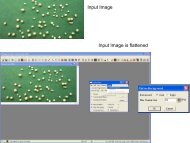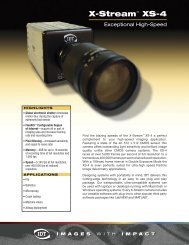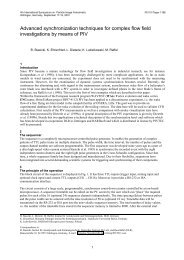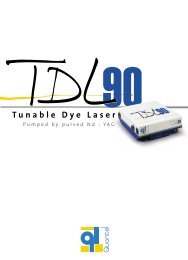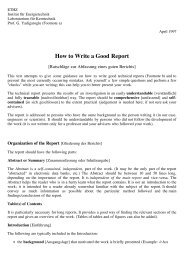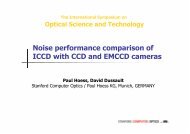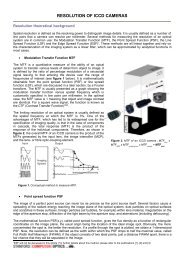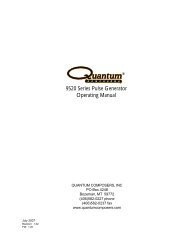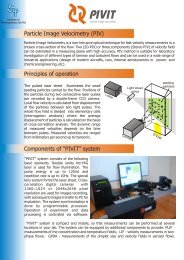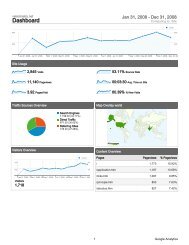mira uses vicon motion capture
mira uses vicon motion capture
mira uses vicon motion capture
Create successful ePaper yourself
Turn your PDF publications into a flip-book with our unique Google optimized e-Paper software.
EngineeringCase StudyMIRAAERODYNAMICS RESEARCHMIRA USES VICON MOTION CAPTURE TO STUDY AIRFLOWVISUALIZATION WITH 3MM BUBBLES AND INCREASEFUEL EFFICIENCY“MIRA CHOSE TO WORK WITH VICON’S T-SERIES CAMERAS BECAUSE OF ITSUNIQUE MIX OF HIGH RESOLUTION, FAST CAPTURE RATES AND PROVENMOTION TRACKING ABILITIES. DATA THAT USED TO TAKE US MONTHS TOGATHER AND ANALYZE, NOW TAKES AN AFTERNOON.”ANGUS LOCKTWENTY-FIVE YEARS OF INNOVATION
EngineeringCase StudyFor over 40 years British automotive testcompany, MIRA, has been recognized as aleading independent product engineering, testingconsulting and certification organization. It strivesto deliver new vehicle systems and componentsby integrating innovative design and simulationtechniques, which are validated in over 30 majortest facilities.Operating across a range of transporttechnologies MIRA provides particular expertisein vehicle safety, aerodynamics, thermalmanagement, NVH (noise, vibration andharshness), EMC (electromagnetic compatibility)engineering, power train integration,environmental engineering and all aspects ofdurability.MIRA’s engineers thrive on diverse and technicallychallenging projects; they’re always able tooffer an innovative approach or solution for itscustomer base, which includes major vehiclemanufacturers, systems and component suppliersand other independent consultants throughoutmost of the vehicle-producing world.THE CHALLENGECar manufacturers increasingly look for ways toimprove the efficiency of their vehicles. Makinga car more aerodynamic has many benefits. Forexample, it improves fuel efficiency, making thevehicle greener, and it will enable the car to travelfaster; particularly useful if you’re a Formula 1driver!Angus Lock, head of Aerodynamics at MIRAsaid,“Fuel efficiency is now more important thanever. Our customers are leading the way, ahead ofthe 2012 EU guidelines requiring all new cars toreduce CO2 emissions to 130g/KM. The problemis, the current analysis methods either don’toffer us enough detail or they take months tocomplete.”Always looking for a challenge, the engineer’s atMIRA started looking to improve the efficiencyof current airflow visualization – a techniqueused to improve the aerodynamics of a vehicle bymonitoring the airflow around it. However, dragreduction techniques are notoriously slow andtime consuming: the most common methodsinclude Particle Image Velocimetry (PIV), whichis limited to a single plane, tomographic PIV orParticle Tracking Velocimetry (PTV), which islimited to academia and small volumes.In 2005, MIRA started to look into a newvisualization method called bubble tracking, using3mm helium filled bubbles. These bubbles arepumped around the rear of a vehicle in a full-scaleautomotive aerodynamics wind tunnel to give anaccurate display of air flow. Previously, it’s alwaysbeen a fairly manual process, limited by verysmall <strong>capture</strong> volumes and the labor intensivetask of processing the data.Lock hoped to track the bubbles using technologymore commonly found in a hospital: <strong>motion</strong><strong>capture</strong>. Lock realized, because of the neartransparent nature of the bubbles, the speed andthe seemingly random way they move around thevolume, he needed a highly accurate system thatwould be sensitive enough to track each bubble inthe 3mx2mx2m wind tunnel to give him accurate,precise airflow data.THE SOLUTIONMIRA worked with Vicon to win funding forthe project from the Department of Trade andIndustry (DTI). The two companies conductedpreliminary research to prove that a Vicon <strong>motion</strong><strong>capture</strong> system could see and track a soapbubble.Andy Ray, EMEA Sales Manager at Vicon said,“Angus came to Oxford with the bubble machineand we tested it in our studio. Our first attemptwas successful! It was fantastic to see, in realtime, the bubbles being tracked and movingacross the screen. We didn’t even need tochemically alter the soap solution.”Seeing the successful results of the project,the DTI awarded MIRA funding to complete itsbubble flow visualization technique, includingthe purchase of a 12 camera T40 <strong>motion</strong> <strong>capture</strong>system.THE RESULTSeveral high profile car manufacturers and twoFormula 1 teams have already successfully usedthe innovative airflow visualization technique.Lock explains, “Measuring the precise location ofhundreds, even thousands of helium filled bubblesgives our clients valuable velocity information, andthey’re able to build up a picture of what the flowis doing around the car.“The continual technical support from Vicon helpsus exploit the T-Series’ class leading technologyin a completely new application area, as well asrapidly getting to grips with the capabilities ofthe system. Our technical partnership with Viconmeans we can continue to deliver a truly worldclass aerodynamic flow visualization technique.”DENVER7388 S. Revere Parkway Suite 901Centennial, CO 80112 USAT: +1 303.799.8686F: +1 303.799.8690LOS ANGELES5419 McConnell Avenue,Los Angeles, CA 90066, USAT: +1 310.306.6131F: +1 310.437.4229OXFORD14 Minns Business Park,West Way, Oxford, OX2 0JB, UKT: +44 (0) 1865 261800F: +44 (0) 1865 240527SINGAPORE8 Cross Street # 11-00PWC Building, Singapore 048424T: +65 6400 3500www.<strong>vicon</strong>.comAll images copyright Vicon Motion Systems 2010.Images Courtesy of MIRA.



